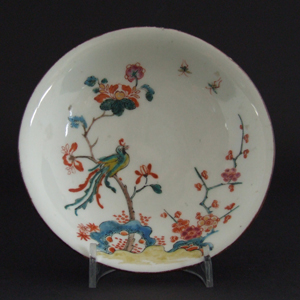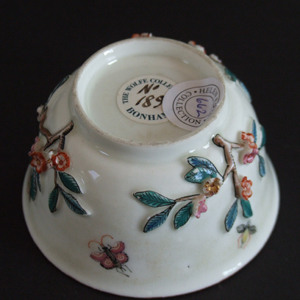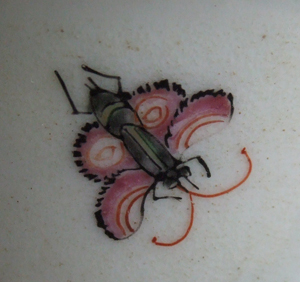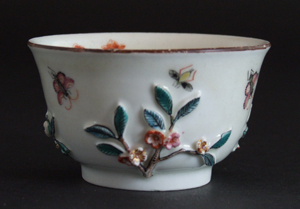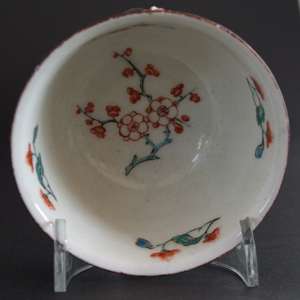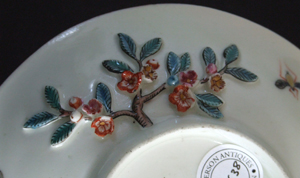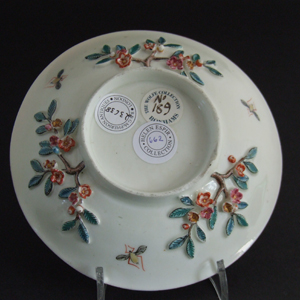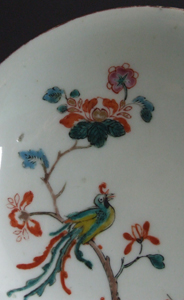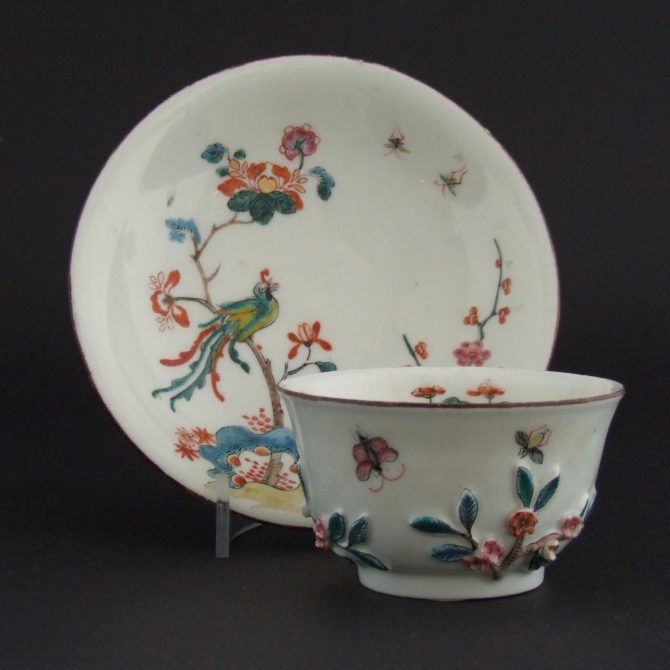
BOTTGER or EARLY MEISSEN c.1715 – 1725 Dutch Decorated Early German Porcelain
A Böttger or Early Meissen Dutch Decorated Teabowl and Saucer c.1715-1725. The White Hard-Pate Teabowl and Saucer in Imitation of Blanc de Chine or Japanese Porcelain with Three Applied Flowering Branches. Decorated in Holland c.1730 in the Kakiemon Style with an Exotic Bird (Hō-ō Bird) Sitting on a Branch of Peony Growing Through a Scholar`s Rock with Prunus to the Side.
SOLD
- Condition
- There are two areas of restoration to the back of the saucer, these are almost certainly coving chips. The tea bowl is in perfect condition.
- Size
- Diameter : 12.5 cm (5 inches)
- Provenance
- Bonham`s Bond Street, Wolfe Collection, lot 19. 17th June 1998. The Helen Espir Collection of European Decorated Chinese Export Porcelain : "a member of the Oriental Ceramic Society and collector, with her husband. Having made a typical collection of Song and provincial Ming blue and white, they decided to concentrate on what used to be called `clobbered` porcelain. She is the author of the standard work on the subject, European Decoration on Oriental Porcelain,2005, the first to examine the work of European decorators on Chinese porcelain throughout the eighteenth and nineteenth centuries, focusing on enamellers in Holland, Germany and England. She has learned Chinese." From Provenance ; Collectors, Dealers & Scholars : Chinese Ceramics in Britain & America (Roy Davids, Dominic Jellinek, Privately Printed, 2011. ISBN 978-0-9570148-0-0). "a member of the Oriental Ceramic Society and collector, with her husband. Having made a typical collection of Song and provincial Ming blue and white, they decided to concentrate on what used to be called `clobbered` porcelain. She is the author of the standard work on the subject, European Decoration on Oriental Porcelain,2005, the first to examine the work of European decorators on Chinese porcelain throughout the eighteenth and nineteenth centuries, focusing on enamellers in Holland, Germany and England. She has learned Chinese." From Provenance ; Collectors, Dealers & Scholars : Chinese Ceramics in Britain & America (Roy Davids, Dominic Jellinek, Privately Printed, 2011. ISBN 978-0-9570148-0-0). Kakiemon Porcelain : Kakiemon decoration is usually of high quality, often delicate and with well-balanced asymmetric designs. The designs were normally quite sparse emphasizing the fine white porcelain body known in Japan as Nigoshide (milky white). The opaque white milky Nigoshide body was used on the finest pieces, it appears that it was reserved for fine quality enamelled decoration. Kakiemon porcelain was decorated with a great variety of imaginative designs which include elements such as the `banded hedge`, `flying squirrel`, and the `Quail and Millet` design. The `Three Friends of Winter` were also a very popular group of designs, other subject taken from nature include flowers (especially the chrysanthemum, the national flower of Japan) as well as birds and rock-work. Figural subjects such as the `Hob in the Well` were also popular. This design illustrates a Chinese folk tale where a sage saves his friend who has fallen into a large fish-bowl by throwing stones at it, braking open the pot. Banded-Hedges were a formal device within Japanese traditional gardens, they were often incorporated in designs, includes `The Three Friends of Winter` (Pine, Bamboo and Prunus). These three plants signify perseverance, as neither the pine nor the bamboo shed their leaves in winter and the plumb (Prunus) flowers at the very end of the winter, heralding the arrival of spring.
- Stock number
- 23638
- References
- For the original Böttger porcelain teabowl maquette by Johann Jacob Irminger dated to after 1713 with a similar sprig design see : Meissen, La Decouverte De La Porcelaine Europeenne en Saxe, J.F. Böttger (Various authoers, Pygmalion 1982. ISBN 2-85704-164-0) plate 189.
Information
Johann Friedrich Böttger 1682-1719 was a German alchemist. He was born in Schleiz, and died in Dresden. He was generally acknowledged as the inventor of European porcelain although more recent sources ascribe this to Ehrenfried Walther von Tschirnhaus. Böttger is still credited with developing the manufacture of porcelain in Europe.
Hō-ō Bird / Ho-Ho Bird :
The Japanese Hō-ō bird is type of auspicious phoenix and is similar to the Chinese Fenghuang. the Hō-ō appears only in peaceful and prosperous times (nesting, it is said, in paulownia trees), and hides itself when there is trouble. As the herald of a new age, the Hō-ō descends from heaven to earth to do good deeds, and then it returns to its celestial abode to await a new era. It is both a symbol of peace (when the bird appears) and a symbol of disharmony (when the bird disappears). The Hō-ō Bird appears frequently in Japanese porcelain of the late 17th and early 18th centuries, especially in Kakiemon wares. Ho-Ho is often used when referring to English porcelain versions of these Kakiemon designs.
